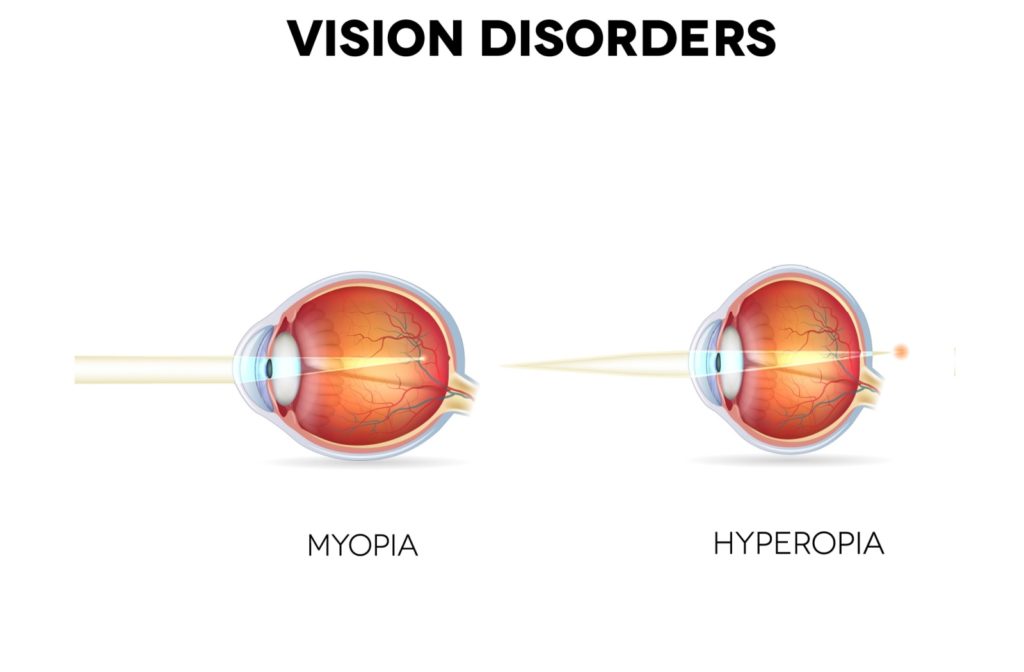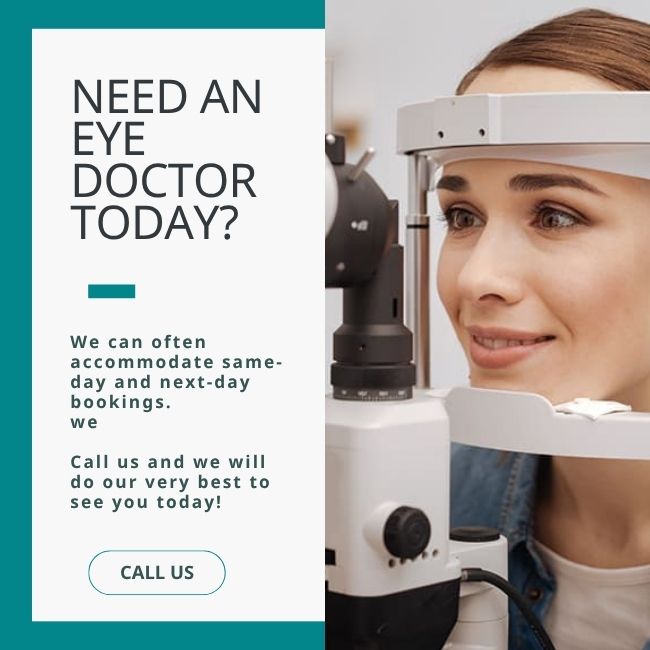Our ability to see the world around us is a true marvel. But sometimes, our eye’s lens doesn’t focus how it should. Several refractive errors can change our vision, 2 common ones being myopia and hyperopia. The main difference between myopia and hyperopia is the distance of vision that they affect.
Neither of these refractive errors has a single “you have it, or you don’t” answer. Rather, each is on a spectrum that requires varying amounts of correction. Early diagnosis is crucial for these refractive errors because each can lead to complications without the proper correction or control methods.
Myopia (Nearsightedness)
Myopia, commonly called nearsightedness, is a refractive error that occurs when the eye is longer than usual or has a cornea that is too steep. Instead of focusing images on the retina, the light focuses in front of it, which causes distant objects to appear blurry. Close-up vision is typically unaffected unless there are other refractive errors at work.
Myopia is extremely common, affecting more than 30% of the world’s population, and experts estimate it’ll rise to 50% by 2050. It also seems to be occurring in younger children than previous generations.
Cause of Myopia
A significant cause of myopia appears to be genetic, with children whose parents have the refractive error being most likely to develop it. It also progresses quickly in these children. Excessive near work, such as reading or electronics use, can also contribute to myopia development.
Overview of Myopia Control
Correcting myopia isn’t simply a matter of producing clear vision. Research indicates that high myopia (severe myopia) is linked to an increased risk of vision-threatening complications, such as retinal detachment, cataracts, glaucoma, and macular degeneration.
Early myopia diagnosis is critical so that your child’s eye doctor can implement myopia control methods to try and slow the refractive error’s progression to minimize future risk. Modern myopia control methods include:
- Orthokeratology
- Specially designed lenses
- Atropine eye drops
- Focus on visual hygiene and time outdoors
There isn’t a one-size-fits-all answer for myopia control. Your child’s eye doctor can offer a tailored treatment plan that possibly utilizes one or more methods.

Hyperopia (Farsightedness)
Hyperopia, often called farsightedness, occurs when the eye is shorter than usual, or the cornea is too flat. This causes light entering the eye to be focused behind the retina instead of directly on it. Unlike myopia, hyperopia affects an individual’s near vision and causes up-close objects to appear blurry while their distance vision remains clear.
Many people have some degree of hyperopia that goes uncorrected because it doesn’t affect their vision enough to be a problem. Complications of hyperopia may be as simple as headaches. Still, children with severe hyperopia could be at a higher risk of developing amblyopia or strabismus, so its early diagnosis is still important.
Cause of Hyperopia
Research into hyperopia’s causes is ongoing, but experts believe that there is a genetic component that dictates whether someone is born with the refractive error. Environmental factors haven’t been ruled out, either.
Symptoms of Myopia & Hyperopia
The most apparent difference is their impact on near or far distances. Myopia hinders far vision, while hyperopia affects close-up activities. Myopia also tends to progress during childhood and stabilize in early adulthood, whereas hyperopia may lessen with age, but an adult can develop presbyopia, which also affects close-up vision.
Symptoms of Myopia
Myopia symptoms can vary depending on its severity, but they include:
- Blurry distant vision
- Headaches
- Eye strain
- Squinting to see distant objects clearly
- Tired eyes while doing things that require focus on distant objects
A few child-specific symptoms include:
- Poor school performance
- Short attention span
- Holding things close to their face
Symptoms of Hyperopia
Hyperopia symptoms may vary based on the refractive error’s severity, but they include:
- Blurry close-up vision
- Nighttime eye fatigue
- Trouble reading
- Double vision when reading
- Dull eye pain
- Strained eyes
- Squinting while reading
How They Affect Daily Life & Activities
The 2 conditions can affect different aspects of life. Myopia might make activities like driving and sports challenging, while hyperopia can lead to difficulties with reading and computer work, where close attention is needed.
Prevention & Management
There isn’t a one-size-fits-all answer for preventing or managing each refractive error because each requires different considerations.
Importance of Regular Eye Exams
Regular eye examinations are crucial for the early detection of vision problems, including myopia and hyperopia. Early intervention can prevent more serious complications and introduce corrective measures early.
Available Corrective Measures
Corrective measures range from traditional glasses or contact lenses to modern solutions such as laser refractive surgeries. These effective treatments can restore clear vision and significantly improve quality of life.
Discuss Your Vision’s Future with Your Eye Doctor
Understanding the difference between myopia and hyperopia empowers individuals to seek appropriate help and underscores the importance of proactive eye care. By familiarizing yourself with the signs, symptoms, and treatments of these conditions, you can take the necessary steps to safeguard your visual health and that of your loved ones.
Contact our team at Trinity Hills Eyecare to book an appointment. One of our experienced eye doctors can perform a comprehensive eye exam to see where your eyes are at and offer tailored approaches to treatment or correction.




